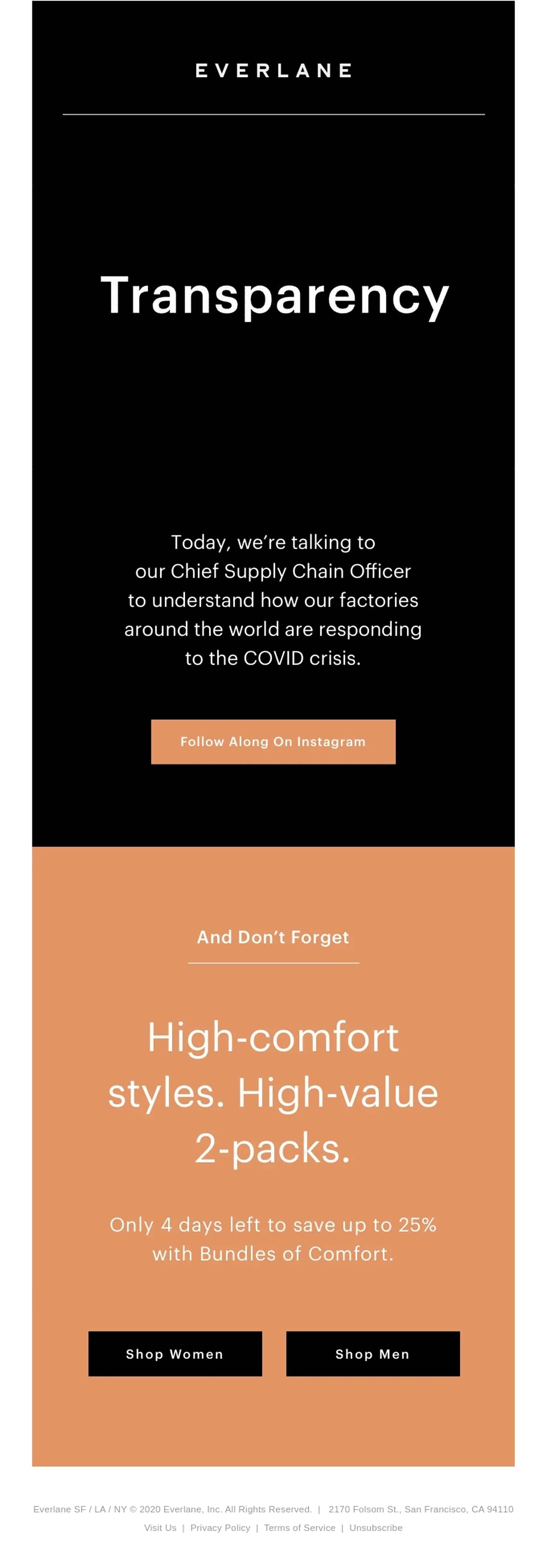The world has undeniably changed due to COVID-19.
Recommended precautionary measures differ by locale, but the overall effect is similar: empty streets, fully occupied homes, and businesses needing to adjust rapidly.
National retailers shut down more than 47,000 physical stores across the U.S. in March alone. Many small companies followed suit. Since then, brands and businesses have pivoted to serve customers better. For some, the shift in approach is a survival tactic.
Let’s examine what responding to COVID-19 looks like for different industries. What are the effects of this unprecedented time on customer relationships and marketing efforts? We’ll highlight some best practices and examples of COVID emails for each field as well.
How is COVID-19 affecting email marketing campaigns?
Compared to statistics from the same period last year, the number of active email campaigns decreased by more than half in March 2020.
Although almost 90% of COVID-19 emails make it to inboxes, they’re not as effective with engagement. Marketers may experience lower open rates and significantly higher delete-after-open rates.
Not all industries have this problem. Emails from food and travel sectors, even in this climate, enjoy read rates above 30%. Surprisingly, some of the lowest read rates belong to messages from medical or health and wellness information establishments.
Too much of the same pandemic-related content could be to blame. Subscribers are more likely to click on practical and considerate emails, no matter which company they’re from.
Here are some great examples of COVID emails, listed by industry.
Below, you’ll find industry-specific email marketing best practices, along with samples to illustrate the advice given.
1. Entertainment
Many will argue that entertainment isn’t essential. However, entertainment can soothe and provide momentary mental relief. This is especially true for people stuck at home with little to do except work and worry.
When writing a marketing email for an entertainment-based company:
- Don’t ignore the current situation. Acknowledge the impact of COVID-19 on your industry.
- Consider what role entertainment plays in your subscribers’ lives. Speak from a place of understanding and don’t be tone-deaf. If the service you provide isn’t needed right now, don’t shoehorn promotions into the conversation.
- Provide specific news and updates that make sense for your brand. Think about what kind of novel coronavirus-adjacent information people expect from you and build a campaign around it.
The StubHub email below follows these best practices effortlessly.
Source: Milled
StubHub has little to do in the way of business now, as they’re a ticketing platform. Instead of quietly going about their way, they’ve strengthened their connection with subscribers by curating live streaming links and providing information on moved tour dates.
2. Food and beverage
The food industry is huge, and many companies that fall within this categorization are essential. However, some simply make survival easier, as opposed to possible.
When creating email campaigns for a food-based brand:
- Rethink and refocus your marketing strategy. If the bulk of your promotions focus on pushy in-store offers, soften the tone and intensity of your emails.
- Check your automation settings. Some automated emails created and set in the past may come across as insensitive now. Don’t forget to suspend or update the content of these campaigns.
- Address COVID-related concerns right away. Let your subscribers know what you’re doing to keep your employees safe, your products uncontaminated, and your customers comfortable.
The Postmates email below is an excellent example of refocusing without sacrificing a company’s business model or identity.
Source: Really Good Emails
What’s striking about this email is its tone. Postmates isn’t outright making jokes, but the text is far from serious. The brand has correctly assumed that most of their subscribers need distractions and an emotional pick-me-up. The promotional CTA at the end—with a brief nod to COVID-related information before the footer—is a nice touch.
3. Finance
The finance sector is similar to the healthcare industry in that they both provide support for life-changing concerns. If you’re worried about your health, chances are you’re worried about how to pay for medical services and long-term quarantine supplies too.
When crafting emails for a finance-centered business:
- Point subscribers to useful resources. Because of COVID-19, many people have taken pay cuts or have found themselves unexpectedly employed. They could use a quick list of helpful resources.
- Create guides and share expert advice. Not everyone is good at managing their finances. Now, more than ever, these people need help to stretch their income beyond its usual reach.
- Use plain English. Like medical terms, financial jargon is inaccessible to the everyman. Even if it seems patronizing, always explain concepts clearly or link to references.
The QuickBooks email below manages to hit all three points while remaining concise and scannable.

There’s no overt promotion of the accounting software product. Instead, there are thoughtfully curated and linked resources for QuickBooks’ target market: small to medium-sized businesses.
4. Nonprofit
There should be no competition when contributing to the greater good. However, running nonprofit marketing campaigns during the time of COVID-19 can lead to conflicting or contradictory messages, if not managed correctly.
When writing marketing messages for nonprofit entities:
- Remind your subscribers of what your organization does. You need to drive home the crucial nature of your mission and how critical it is to continue what you do, even with COVID-19.
- Explain what your nonprofit can do to help during this time. What’s the direct impact of your work on people affected by the pandemic? Let your subscribers know that you’re doing your part too.
- Create easy ways for your subscribers to donate. Pandemic or not, this is good advice. Donating should be a single-task affair.
The Charity: Water email below focuses on the obvious intersection of the nonprofit’s aim and preventing the spread of COVID-19.
Source: Milled
Talking about handwashing reminds subscribers of what Charity: Water does, while addressing current events. The CTA links to a quiz that unlocks a donation without requiring subscribers to send money themselves too.
5. Retail
Retailers, by definition, survive by selling products or services to consumers for a profit. It’s a challenge to stick to that business model when so many are losing jobs, earning less, or struggling more than usual to make ends meet.
When creating marketing campaigns for retailers:
- Show subscribers how your brand is responding to COVID-19. Explain how you’re taking care of your employees or partnering with charities. People are more likely to spend on non-essentials if they know their money will help others.
- Be considerate and sensitive. Consider segmenting your list and sending sales pushes only to verified or loyal customers.
- If possible, don’t lead with promotions and offers. If you have more relevant information to share, make that the point of your email. You don’t want to come across as callous or self-serving.
The Everlane email below is short and sweet without sacrificing crucial content.
Source: Really Good Emails
The U.S. clothing retailer takes pride in its transparent approach to pricing. A reference to this appears in the lead section, sidestepping a discussion of COVID-19 measures. Instead, there’s a cleverly provided link to the brand’s Instagram. Finally, the message ends with a simple but enticing offer.
6. Software and technology
Certain players within this industry are near-essential, due to quarantine conditions. Communication and productivity applications are musts for many remote jobs. Crossovers into the entertainment industry—like creative programs or video games—are also lucrative.
When writing emails for this industry:
- Create practical content for work-from-home newbies. This is immediately engaging and often related to software-based brand offerings.
- Offer discounts or free trials. Companies pivoting to remote solutions may be more inclined to choose your product or service if you do so.
- Don’t send a wall of text. If you must send emails in letter form, have the text edited for length and readability.
Productivity and project management platform Asana delivers a get email example below.
Source: Really Good Emails
The best practices are vividly executed in this email, and the message contains genuinely useful content presented in an attractive and digestible format.
7. Travel and hospitality
You’d think these businesses would pause their email marketing efforts, due to multiple enforced domestic travel bans. However, their emails are among the most read, likely due to concerns dealing with refunds and postponements.
When crafting campaigns for travel and hospitality brands:
- Show compassion and flexibility. It’s frustrating to process business transactions that reduce profits. Don’t let it get to you and bank on cultivating customer loyalty through excellent service.
- Provide actionable information pertaining to your industry. Guide your subscribers through the process of canceling or rescheduling their trips—including steps that don’t directly fall within your responsibility. Be helpful.
- Move away from tourism-related content. It’s irresponsible, insensitive, and dangerous to push these types of campaigns while COVID-19 remains uncontained.
The Skyscanner email below is concise, effective, and elegant.
Source: Really Good Emails
No promotions or lengthy paragraphs here. Instead, there’s a short message sandwiched between a heartwarming header and a simple CTA button. The latter links to a curated feed of COVID-19 updates and travel advice.
Wrap up
Responding to COVID-19 as a business needs nuance. It’s not wise to go for a one-size-fits-all approach.
The same holds true for marketing efforts. Effective examples of COVID emails show that what works for one industry may not necessarily be the best fit for another. Also, a disproportionate focus on pandemic-related content without industry-specific elements isn’t enough to consistently engage subscribers.
Above, we discussed email best practices for the following sectors:
- Entertainment
- Food and beverage
- Finance
- Nonprofit
- Retail
- Software and technology
- Travel and hospitality
Practical, relevant, and compassionate content is the way to go.
Looking for more examples of COVID emails to inspire your brand’s response to the novel coronavirus outbreak? Find great advice in Campaign Monitor’s updated guide for businesses.











